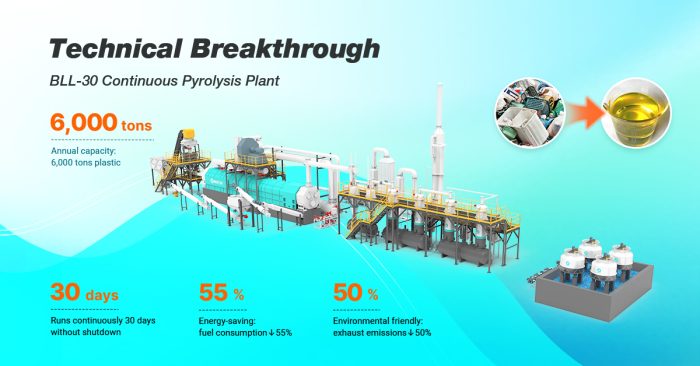Every year, billions of used tyres are discarded globally, contributing to serious environmental concerns due to their non-biodegradable nature and potential for pollution. Traditional recycling and disposal methods, including landfilling and incineration, pose significanpyrolysist risks to soil, air, and water quality. In response, pyrolysis technology has emerged as a cleaner, more efficient solution to recover valuable energy and materials from waste tyres. Yet, the transformation of pyrolysis from batch processing to a truly continuous tyre pyrolysis plant has been a significant technical challenge — until now.
Breaking the Cycle of Downtime
The shift from batch to continuous processing in the tyre pyrolysis plant marks a new era of operational efficiency. One of the most significant hurdles in continuous systems has been equipment downtime due to oil-gas system blockages caused by polymerization of olefin compounds. A cutting-edge oil-gas condensation technology now offers a solution. This method utilizes direct spray-mixing condensation to rapidly cool pyrolysis gases, increasing condensation efficiency and preventing secondary reactions that could otherwise block pipelines. Plants implementing this breakthrough can run non-stop for 30 days or more without the need for maintenance shutdowns.
Smart Temperature Control for Precision and Safety
Achieving precise thermal control in pyrolysis is critical for maximizing yield and ensuring safe operation. The latest generation of systems integrates intelligent temperature regulation through a combination of multi-medium automatic combustion valve sets and hot air recycling. This automatic temperature control system adapts to different fuel types, adjusting the air-fuel mix dynamically. With a control accuracy of ±10°C, the process becomes not only more efficient but also significantly safer, reducing the risk of overheating or underperformance. This high level of automation minimizes the need for human intervention and allows for simple and stable operation.
Energy Efficiency and Environmental Impact
Energy consumption and emissions have always been major considerations in pyrolysis plant. Innovative systems now incorporate hot smoke reuse and preheated air distribution technologies. Around 80% of high-temperature flue gases from the furnace are redirected into the combustion chamber, mixed with high-temperature hot air from the burner at temperatures between 1000°C and 1300°C. This mixture is then used to heat the reactor. Meanwhile, the remaining 20% of the flue gas is subjected to waste heat recovery and used to preheat fresh combustion air. This dual approach results in a 55% reduction in fuel energy consumption and a 50% reduction in exhaust emissions. The significantly cleaner exhaust makes it easier to meet stringent environmental regulations and lowers investment in expensive tail gas treatment systems.

Integration of Smart Control Systems
Another cornerstone of the recent technological leap is the integration of advanced automation. These systems are equipped with sensors and intelligent control algorithms that monitor and adjust process parameters in real time. This includes the feed rate of shredded tyres, reactor temperatures, gas flows, and condensation stages. By leveraging the latest in industrial IoT, a smart control system offers operators a comprehensive dashboard with alerts, performance metrics, and predictive maintenance warnings. This leads to improved process transparency and enhanced decision-making capabilities.
Economic Advantages for Plant Operators
Continuous tyre pyrolysis plants are proving to be a game-changer for business owners in the recycling industry. Reduced downtime, lower fuel consumption, and simplified operation mean substantial cost savings and improved ROI. Moreover, with fewer interruptions and extended continuous operation cycles, plant throughput and annual production capacity increase. Combined with fewer breakdowns and lower labor requirements, the total cost of ownership for these plants is significantly lower than their batch-processing predecessors.
Product Yield and Market Value
Continuous pyrolysis technology also enhances the quality and consistency of end products, such as fuel oil, carbon black, and steel wire. With better thermal control and faster condensation, the recovered oil has fewer impurities and a higher calorific value, making it more desirable in secondary fuel markets. Carbon black can be more easily refined for reuse in rubber and plastic industries. These product improvements translate into higher selling prices and broader market applications, maximizing revenue potential for operators.
Environmental Compliance Made Easier
Stricter environmental regulations are pushing industries to adopt cleaner technologies. Thanks to advanced energy-saving methods and lower emissions, continuous pyrolysis systems are designed with compliance in mind. Technologies like waste gas reuse and reduction make it easier to meet emission targets without the need for large-scale post-treatment systems. This not only reduces capital expenditure but also streamlines the permitting process for new installations.
Scalability and Global Adoption
Modular design and automation make continuous pyrolysis plants scalable and adaptable to various production requirements. Whether a facility is processing 5 tons or 50 tons per day, the system can be tailored to suit different capacities. Additionally, the plug-and-play nature of modern designs allows for faster installation and commissioning, accelerating time to market. These features are making the technology attractive not only to large-scale recyclers but also to regional operators around the world looking to tap into the green economy.
The Road Ahead
The technological breakthroughs in continuous tyre pyrolysis signal a paradigm shift in how the world handles waste rubber. Beston Group is glad to have you come for consultation. As environmental awareness increases and demand for renewable resources grows, this technology offers a sustainable and economically viable path forward. With continued investment in research and innovation, further enhancements are expected in the coming years — including AI-powered process control, more efficient material separation, and even greater energy integration with renewable sources. The future of tyre recycling is not just about waste reduction — it’s about building a circular economy that turns problems into profit.